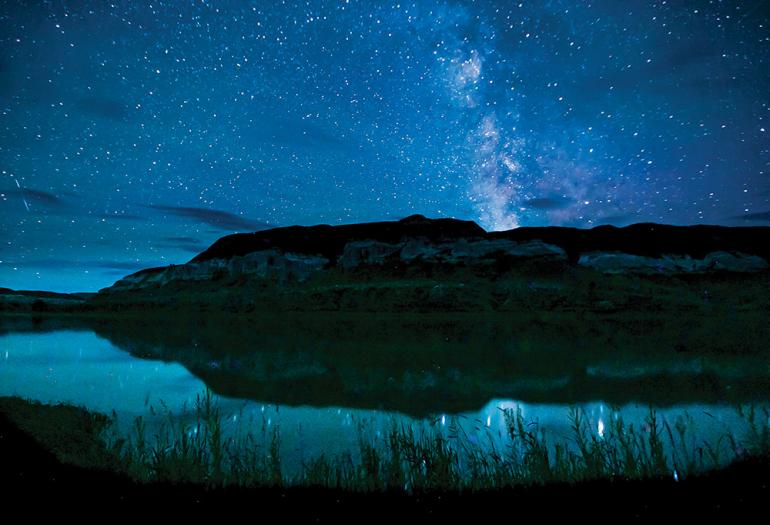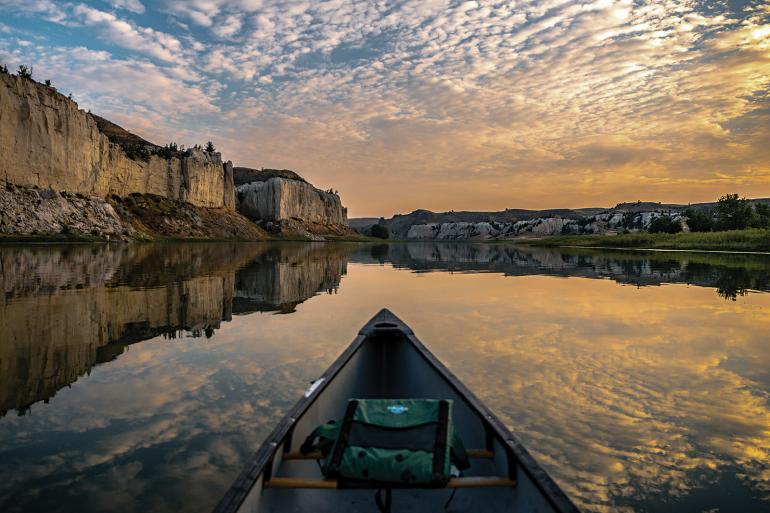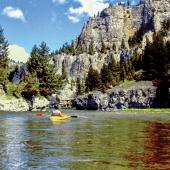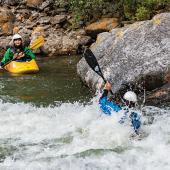Moon River
An unorthodox outing on the Mighty Mo.
Like so many of our outings, it started with, “We should do this...” But this time we elaborated: “We should do this on a full moon.” Our horizons had expanded outside the immediate confines of the Bozone, and “this” meant a 108-mile float through the Missouri Breaks aboard Blue, our old 18-foot tandem sea kayak.
Fast-forward a year, and we’re launching from the Coal Banks boat ramp at 4pm on what will be a full-moon night in early summer. We expect about 20 hours of river time, with current and a nice steady paddlestroke. The inspiration for this trip was sparked the last time we floated this stretch, when we witnessed abundant wildlife, impressive lightning, and a splendid variety of landscapes—though that outing took over five days in a canoe. This is going to be different.
Our load is minimal: a cooler with snacks, rain gear, small stove, and headlamps. We say goodbye to our shuttle crew, who will meet us at the Fred Robinson Bridge tomorrow at noon, and we shove off. There is a hint of anxiety and excitement in the boat. What changes had the passing seasons brought to the Mighty Mo? Would we encounter floating debris, downed trees, the fabled Missouri wind? With only one way to find out, we quietly make our way down the river that has flowed through these hills for thousands of years. As the miles pass I drift into an unconscious rhythm. My movements are effortless; our environment is calm and serene. I’m reminded why floating is my favorite way to travel.
At 10pm twilight has just begun. The last six hours have lulled us into a foggy state of nature-filled bliss. Echoing off the walls comes a crack like a rock breaking free of its hold. We sit up, startled, looking around for the impending attack. Nothing. Then again comes the noise, this time closer and more like a rifle shot—we catch a glimpse of water fountaining up, and the sleek shape of a brown body. Who would have known a beaver tail could make such an explosion of noise?
Fully awake and alert again, we can see where the moon will break. Over the top of a bench, an orange glow radiates from the rocks as the huge orb slowly rises out of the earth. It is a monster of pink, blue, and orange directly in our path. Behind us, the sunset fires the horizon. Delighted, we do not paddle, content with being carried through the middle of these two masterpieces of nature.
Settling into its normal spotlight white, and shrinking in size, the moon lays down a laser-beam reflection, aligned perfectly with our bow. Amazing how it works like that. Just before complete darkness, we pass a group of men setting up camp on shore near an old cottonwood. They are dressed in buckskin and flannel and have long-poled their way up the river in a keelboat in the manner of Lewis & Clark. While I relish my downriver travel, I am jealous of the mental and physical fortitude it took to envision and accomplish an expedition of such magnitude.
As the moon rises, we continue uneventfully on our way. We look around and try to remember this spot and that, where we camped, the rock forms, the geology. While some are recognizable from our daytime trip, most are unfamiliar in the light of the moon. The occasional landing to stretch and water a tree is our only deviation from the rhythmic paddle pace we easily settle into. At 2am, we stop at Judith’s Landing to take a break on the boat ramp. It is quiet, with no wind, bugs, or people. It is also chilly, so we get out our stove and make ourselves a cup of coffee to bring in the kayak. After 15 minutes we carry on, not talking, just listening to the water move around us. Things are louder in the night, especially in the quiet. We hear what sounds like big rapids ahead of us. We perk up and contemplate using our headlamps to identify the obstacle, if any. And then, before we make a move, we are gliding over a little riffle and the big water sound recedes behind us. We chuckle at our nerves.
|
|
|
In the predawn light, we spot deer along the edge of the river, geese waking up—stretching their necks and making a ruckus—and an eagle on its perch patiently watching for prey. Life, land, and water, all dancing to a song that has played for millennia, and of which we are but a single note.
As the early-morning sun begins to warm our bones, fatigue washes over us. My paddling partner requests a moment to close his eyes—just a short nap, he says. I agree to keep watch. But some things you just can’t control, and when I wake, some unknown time later, I see that we are very close to the bank. I look around to get my bearings and, to my surprise, we are in a narrow stream, not the same water we fell asleep on. Blue has found her way into a side channel, maybe 40 feet wide. My first thought: Where am I? My second thought: I hope I don’t have to paddle upstream to get back to the river. “Good thing the navigation system was working,” I say, jokingly referring to old Blue’s apparent autopilot feature. Fortunately for us, side-channels usually find their way back to the river, and within a few minutes we emerge from the slack water and re-enter the main channel.
We both comment on how we should have had our shuttle crew meet us at Judith’s Landing, as our backsides and shoulders are feeling the night’s work. But soon, things start to look familiar again, and we know our moonlight cruise is about to end. Just as predicted, it is noon as we land at James Kipp. Our shuttle friends have only just arrived and have barely had time to cast a lure by the time we pull in. They express some incredulity at the easy success of our harebrained idea, and they are glad to have played a part in it.
Back in the car driving 80 miles an hour, I stiffen up and get sleepy as the view out the window blasts past. Our speed of travel seems unnatural; views of the landscape whizzing by in a furious blur. So unlike floating a river—my favorite way to travel.
If You Go
The Upper Missouri Breaks National Monument has no shortage of country to explore, and via boat is a great way to do it. Here are a couple things to keep in mind before you set off.
There are nine boat ramps inside the monument, 11 if you include Loma and Evans Bend east of Fort Benton. A great float is through the White Cliffs from Coal Banks to Judith Landing. Most folks do this as a four-day, three-night excursion, but with paddles in the water you should be able to trim a day or two.
There is one developed campground inside the monument (Eagle Creek), but expect the rest of your nights to be spent at primitive sites.
Plan your shuttle ahead of time, and the visitor center in Fort Benton can help with this. The Missouri Breaks are famous for gumbo-like mud after rains, preventing vehicles from getting in or out. Check the forecast and call (406) 538-1900 for updated conditions.
Be prepared for windy days. Whitewater isn’t something that comes to mind when thinking of the Missouri, but afternoon gusts on the Mighty Mo have swamped more than one small craft. Safe travels and happy boating. —the editors

















